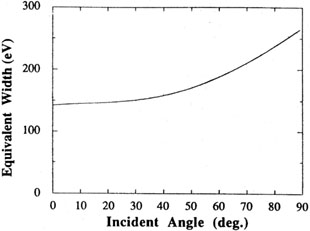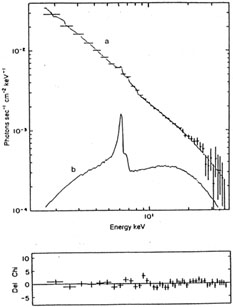


2.3.3 X-ray Reflection and Absorption
Figure 3 shows a single power law fit to the
composite spectrum of 12
Ginga observations of 8 Seyferts, whose detailed X-ray properties have
been described in Refs.
58-64. The
data-minus-model residuals in the
lower figure comprise an Fe emission line at 6.4 keV, a dip in the
7-10 keV range and another excess above 12 keV, all of which
presumably arise from reprocessing of incident radiation from the
central hard X-ray source. The line, which typically has an equivalent
width (EW) ~ 150 eV and a breadth (FWHM) ~ a few keV, has been found
in  90% of all
Seyferts. 65
Figure 4 shows how the EW depends on the
incident angle
90% of all
Seyferts. 65
Figure 4 shows how the EW depends on the
incident angle  , assuming that
hard X-rays impinge on a semi-infinite
slab of optically thick matter. The solid angle assumed equals 4
, assuming that
hard X-rays impinge on a semi-infinite
slab of optically thick matter. The solid angle assumed equals 4 , so
the expected EW becomes
, so
the expected EW becomes 
 / 4
/ 4 times smaller, where
times smaller, where 
 is the ``real''
solid angle. Obviously, observed widths can only be reproduced by a
very large
is the ``real''
solid angle. Obviously, observed widths can only be reproduced by a
very large  -value, i.e., the
hard X-rays should hit the surface at
almost grazing incidence, as in the case of an accretion disk. A
spherical geometry cannot produce an EW in excess of ~ 100 eV, and is
therefore ruled out. 57 The
accretion disk must also be optically
thick, in order to produce enough fluorescence flux.
64 The
observed
correlation between the EW and the relative strength of the soft
excess also supports the presence of an accretion disk.
66
Nandra 65 et
al. argued that the accretion disk picture seems consistent with
available data, in spite of some remaining problems (see below).
-value, i.e., the
hard X-rays should hit the surface at
almost grazing incidence, as in the case of an accretion disk. A
spherical geometry cannot produce an EW in excess of ~ 100 eV, and is
therefore ruled out. 57 The
accretion disk must also be optically
thick, in order to produce enough fluorescence flux.
64 The
observed
correlation between the EW and the relative strength of the soft
excess also supports the presence of an accretion disk.
66
Nandra 65 et
al. argued that the accretion disk picture seems consistent with
available data, in spite of some remaining problems (see below).

|
Figure 3. Single power law fit to the composite spectrum of 8 Seyferts, observed by Ginga. A spectral index ~ 0.7 seems to be indicated, but note the residuals in the lower part. An improved model which takes these into account is shown in Fig. 5. From Ref. 57. |

|
Figure 4. Equivalent widths as a function
of incident angle |
The observed FWHM values are consistent 48 with gravitational and Doppler broadening at a typical radius ~ 10rg. The 6.4 keV line profile may thus yield important information about physical conditions in the inner disk. A general relativistic formula for the ratio between emitted and observed photon energies, using the Schwarzschild metric, is 67
where
Typical profiles obtained using this procedure show some
similarities with the double peaked ones in standard theory, but in
this case the blue horn appears much brighter than the red one, due to
time dilation, aberration and blueshift. A high inclination angle has
a similar effect. For low inclination angles i the line profile peaks
close to its rest energy, but a gravitationally redshifted wing
becomes apparent for small radii. The line width increases with i, as
does the centroid energy. However, Matt et al.
69, 70 have showed that
additional features emerge between the two horns for high inclination
angles, due to a general relativistic effect. It follows that both the
line width and the centroid energy have maxima at about i ~
80°.
In principle, X-ray line and continuum variability correlations may
be used to map out the core region in AGN, since line-emitting regions
close to the central source should be the first to respond to a
continuum change. Fabian 48 and Stella 71 argued that
the space-time
metric and the central mass may then be directly measurable.
Recent observations have cast some doubts on this procedure.
72 The
accretion disk should be highly inclined in about 15% of a sample of
randomly oriented objects, causing an unobserved centroid redshift
As regards the other residuals in
Fig. 2, the absorption feature at
~ 7-10 keV has been identified with edge absorption, which has also
been found in some SBHCs. 57 The excess above 10 keV has been
attributed to Comptonized flux which grows with energy, until
saturation sets in at a few tens of keV, partly due to incoherence of
the scatterings, 31 and partly to the increase of penetrative power,
which increases the number of scatterings before the radiation can
escape. 73
Figure 5 shows a model which includes the above
reflection
components (iron K-line and edge), as well as a power law. The
spectral index for the ``new'' power law fit is ~ 0.9, somewhat steeper
than the standard value.
Figure 5. (a) Multi-component fit to the
same data as in Fig. 3,
composed of a power law, the Fe line and edge and a ``warm
absorber''. (b) Reflection component only. From Ref.
49.
To summarize, it is now established that most Seyfert galaxies
indeed show the above X-ray reflection features. The same applies to
quasars (QSOs) nearby enough (or bright enough) to yield good-quality
X-ray spectra, such as 3C 273 and E1821 + 643.
66, 74, 75 Models which have
the ability to include these features will (if successful) have a
significant predictive power, but the information content as to the
geometry of the reprocessing region, its size and the mass of the
central object seems limited at present. However, the fact that X-ray
reflection features and a hard X-ray power law with about the same
spectral index have been found in both AGN and X-ray binaries may
imply that detailed knowledge of the central engine may be gained by
comparing different types of objects, using forthcoming X-ray
satellites.

 =
2rem (1 + tan2
=
2rem (1 + tan2 ) / rg,
) / rg,  and
and  being two angles from
geometrical optics. Integrating Eq. (6) over the line emitting part of
the accretion disk enables a calculation of the line profile.
68 The
first term contains the dependence on radius, i.e., the gravitational
redshift, whereas the second one yields the kinematic Doppler-shift,
which can be either ``blue'' or ``red''.
being two angles from
geometrical optics. Integrating Eq. (6) over the line emitting part of
the accretion disk enables a calculation of the line profile.
68 The
first term contains the dependence on radius, i.e., the gravitational
redshift, whereas the second one yields the kinematic Doppler-shift,
which can be either ``blue'' or ``red''.
 0.2 keV. It is unclear whether this is due to a selection effect,
caused by absorption. Furthermore, the large EW (~ 160-300 eV)
observed in some sources (such as NGC 6814) seems difficult to explain
using the simple models adopted so far.
65
0.2 keV. It is unclear whether this is due to a selection effect,
caused by absorption. Furthermore, the large EW (~ 160-300 eV)
observed in some sources (such as NGC 6814) seems difficult to explain
using the simple models adopted so far.
65
